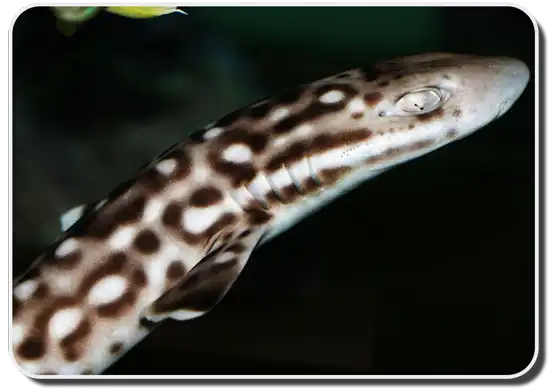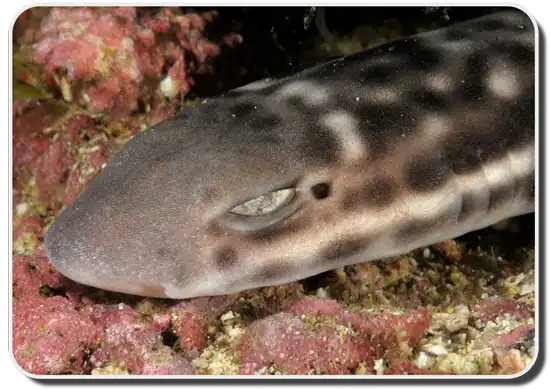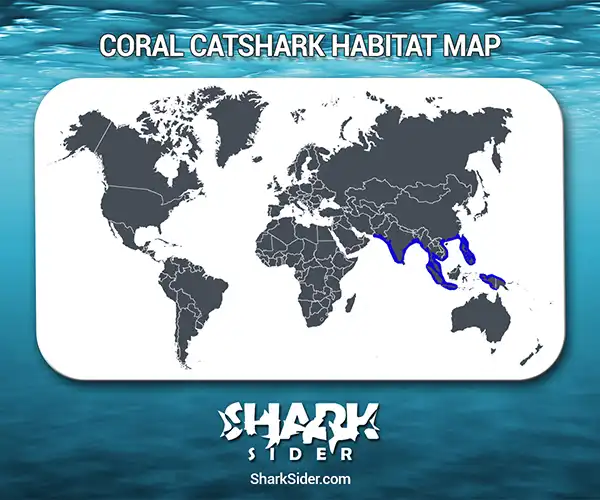Coral catsharks are a small, tropical species of catshark belonging to the family Scyliorhinidae.
They are shy creatures with cat-like eyes that live in the shallow water surrounding coral reefs, thus earning them their name. It was initially named Scyllium marmoratum, with marmoratus, a Latin word translating to marbled in English. Hence these sharks are alternately called the marbled catshark. It was not until 1913 that Samuel Garman placed the shark into his newly created genus, Atelomycterus.

Coral Catshark Scientific Classification
|
|
| Kingdom | Animalia |
| Phylum | Chordata |
| Class | Chondrichthyes |
| Order | Carcharhiniformes |
| Family | Scyliorhinidae |
| Genus | Atelomycterus |
| Scientific Name | Atelomycterus marmoratus |
Description
Coral catsharks grow up to 28 inches in length.
They have slender, cylindrically shaped bodies with varying colors. Their body has a grayish background covered with prominent black and white spots that cluster together to form horizontal dashes. These dashes are present as a white stripe through their gill slits. The tips of their dorsal fins are white, leading to a white underside.
These sharks have thick skin covered by dermal denticles full of calcium.
The head is short and narrow, with a flattened snout ending in a blunt tip. Nictitating membranes, which act as a third layer of skin, cover their horizontally oval eyes with moderately sized spiracles (openings that lead to respiratory systems) behind them.

They have large nostrils covered with broad triangular skin flaps reaching the mouth.
Long furrows at the corner of their elongated mouth extend onto both jaws. Each jaw contains rows of tiny teeth, with each tooth consisting of a narrow central cusp and 1-2 cusplets on either side.
Five pairs of gill slits are visible on either side behind the head of the coral catshark.
These fishes have large pectoral fins. Originating behind the back of the base of the pelvic fin is the first dorsal fin that tilts a little towards the back. The second dorsal fin, similar to the first in shape, is smaller than the latter. Their anal fin is much smaller in size in comparison to the dorsal fins. The relatively short but broad caudal fin has an unclear lower lobe. In contrast, the upper lobe possesses a ventral notch towards its tip.
Where do they live
Map Of The Coral Catshark’s Habitat

The coral catshark is the most widely distributed member of its genus Atelomycterus. Its population ranges from Pakistan and India to Southeastern countries like the Philippines and Taiwan and New Guinea island. Its numbers also extend far north to the Ryukyu Islands.
They inhabit inshore coral reefs and dwell at depths of around 49 ft.
Behavior
Social
This fish is active at night and the twilight hours and sleeps during the day. Foraging usually commences in the afternoon and ends before sunrise. It hides in shelters such as overhanging reefs or hollow logs during the day, either singly or in groups. Records show that individual sharks have returned to the same hiding place on back-to-back days.
Dietary
The general diet of this species consists of small bottom-dwelling invertebrates and bony fishes.
In captivity, the coral catsharks have been known to lie still and lunge to attack any prey near them.
Reproductory
 Coral catsharks follow an oviparous (young ones hatch from eggs outside the female’s body)mode of reproduction. The female produces a couple of eggs at a time and deposits them on the surface bottom. The eggs are individually enclosed in a 2.4-3.1 inches long and 0.79 inches wide capsule shaped like a purse with two waist-like constrictions. These capsules are light brown when laid initially, but they darken over time. While one end of the capsule is squared, the other bears two horn-like small projections that sometimes terminate into tendrils. The embryos feed solely on the yolk while present inside the egg.
Coral catsharks follow an oviparous (young ones hatch from eggs outside the female’s body)mode of reproduction. The female produces a couple of eggs at a time and deposits them on the surface bottom. The eggs are individually enclosed in a 2.4-3.1 inches long and 0.79 inches wide capsule shaped like a purse with two waist-like constrictions. These capsules are light brown when laid initially, but they darken over time. While one end of the capsule is squared, the other bears two horn-like small projections that sometimes terminate into tendrils. The embryos feed solely on the yolk while present inside the egg.
The eggs hatch after 4-6 months of gestation at a temperature of 79 °F. Newly hatched sharks are 3.9–5.1 inches long and marked with vertical bars alternating in light and dark shades. Some specimens would have a combination of black and white dots alongside the bars.
Males of this species reach the point of sexual maturity when they have grown up to 19–24 inches, whereas females hit this stage when they’re 19–22 inches, respectively.
Adaptations
The coral catshark’s firm, slender and elongated body allows it to access compact spaces otherwise inaccessible in the reef environment.
Interactions with humans
Due to their small size, harmless nature, and attractive appearance, these fishes have been in demand for home-based aquariums. These sharks are pretty aggressive and often attack larger individuals inside the tank. They inhibit the aquariums’ deeper regions, a place they naturally prefer to hide. They can reproduce in aquariums and are capable of living up to 20 years.
In eastern Indonesia and elsewhere, these coral catsharks are seldom caught in small numbers incidentally during reef fishing. Although processed for its meat and liver oil, the catshark’s small size limits its economic demand.
Destruction of coral reefs and increased fishing pressure may threaten this species soon.
Though no particular conservation practices are currently underway for this species, the protection of its natural habitat and proper education about the fish should be considered by organizations in the future. The IUCN classified this species as ‘Near Threatened’ in May 2020.
